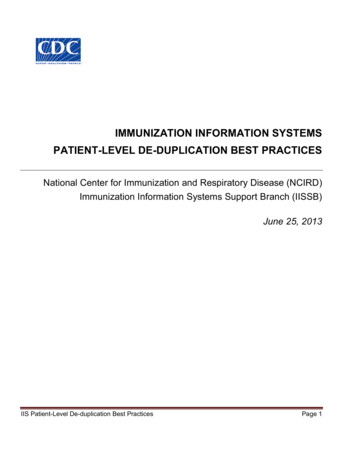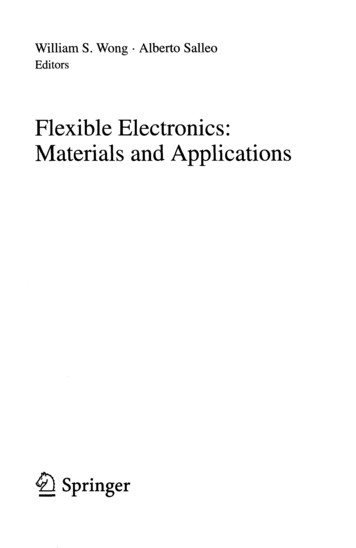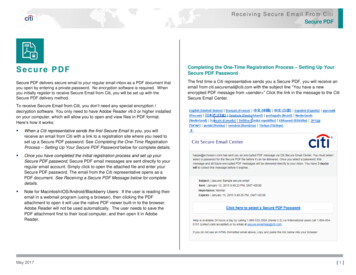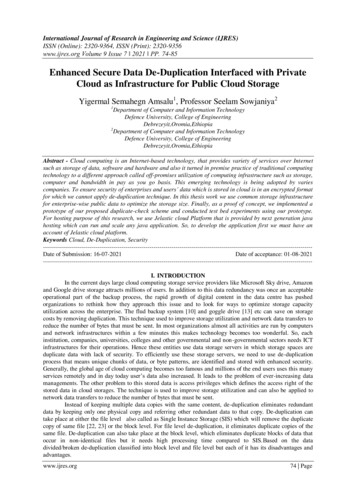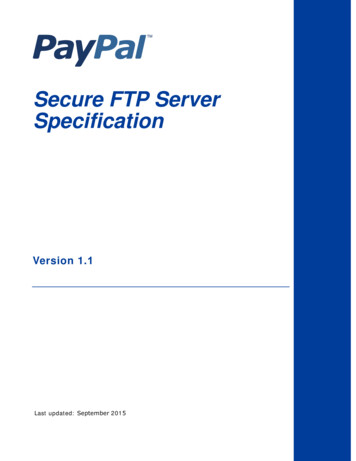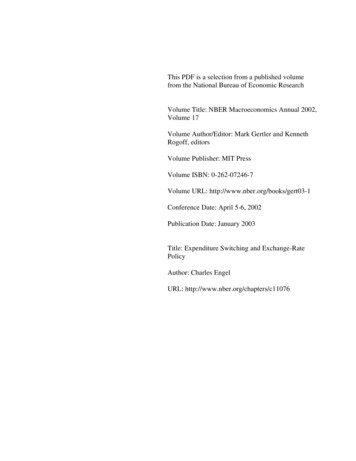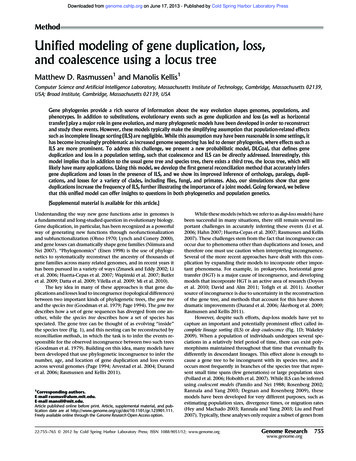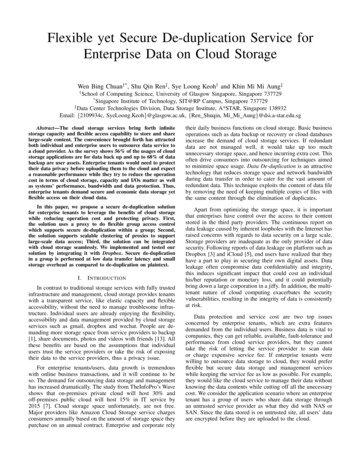
Transcription
Flexible yet Secure De-duplication Service forEnterprise Data on Cloud StorageWen Bing Chuan†* , Shu Qin Ren‡ , Sye Loong Keoh† and Khin Mi Mi Aung‡†School of Computing Science, University of Glasgow Singapore, Singapore 737729*Singapore Institute of Technology, SIT@RP Campus, Singapore 737729‡Data Center Technologies Division, Data Storage Institute, A*STAR, Singapore 138932Email: {2109934c, SyeLoong.Keoh}@glasgow.ac.uk, {Ren Shuqin, Mi Mi Aung}@dsi.a-star.edu.sgAbstract—The cloud storage services bring forth infinitestorage capacity and flexible access capability to store and sharelarge-scale content. The convenience brought forth has attractedboth individual and enterprise users to outsource data service toa cloud provider. As the survey shows 56% of the usages of cloudstorage applications are for data back up and up to 68% of databackup are user assets. Enterprise tenants would need to protecttheir data privacy before uploading them to the cloud and expecta reasonable performance while they try to reduce the operationcost in terms of cloud storage, capacity and I/Os matter as wellas systems’ performance, bandwidth and data protection. Thus,enterprise tenants demand secure and economic data storage yetflexible access on their cloud data.their daily business functions on cloud storage. Basic businessoperations such as data backup or recovery or cloud databasesincrease the demand of cloud storage services. If redundantdata are not managed well, it would take up too muchunnecessary storage space, and hence incurring extra cost. Thisoften drive consumers into outsourcing for techniques aimedto minimize space usage. Data De-duplication is an attractivetechnology that reduces storage space and network bandwidthduring data transfer in order to cater for the vast amount ofredundant data. This technique exploits the content of data fileby removing the need of keeping multiple copies of files withthe same content through the elimination of duplicates.In this paper, we propose a secure de-duplication solutionfor enterprise tenants to leverage the benefits of cloud storagewhile reducing operation cost and protecting privacy. First,the solution uses a proxy to do flexible group access controlwhich supports secure de-duplication within a group; Second,the solution supports scalable clustering of proxies to supportlarge-scale data access; Third, the solution can be integratedwith cloud storage seamlessly. We implemented and tested oursolution by integrating it with Dropbox. Secure de-duplicationin a group is performed at low data transfer latency and smallstorage overhead as compared to de-duplication on plaintext.Apart from optimizing the storage space, it is importantthat enterprises have control over the access to their contentstored in the third party providers. The continuous report ondata leakage caused by inherent loopholes with the Internet hasraised concerns with regards to data security on a large scale.Storage providers are inadequate as the only provider of datasecurity. Following reports of data leakage on platform such asDropbox [3] and iCloud [5], end users have realized that theyhave a part to play in securing their own digital assets. Dataleakage often compromise data confidentiality and integrity,this induces significant impact that could cost an individualhis/her reputation or monetary loss, and it could potentiallybring down a large corporation in a jiffy. In addition, the multitenant nature of cloud computing exacerbates the securityvulnerabilities, resulting in the integrity of data is consistentlyat risk.I.I NTRODUCTIONIn contrast to traditional storage services with fully trustedinfrastructure and management, cloud storage provides tenantswith a transparent service, like elastic capacity and flexibleaccessibility, without the need to manage troublesome infrastructure. Individual users are already enjoying the flexibility,accessibility and data management provided by cloud storageservices such as gmail, dropbox and wechat. People are demanding more storage space from service providers to backup[1], share documents, photos and videos with friends [13]. Allthese benefits are based on the assumptions that individualusers trust the service providers or take the risk of exposingtheir data to the service providers, thus a privacy issue.For enterprise tenants/users, data growth is tremendouswith online business transactions, and it will continue to beso. The demand for outsourcing data storage and managementhas increased dramatically. The study from TheInfoPro’s Waveshows that on-premises private cloud will host 30% andoff-premises public cloud will host 15% in IT service by2015 [7]. Cloud storage space unfortunately, are not free.Major providers like Amazon Cloud Storage service chargesconsumers annually based on the amount of storage space theypurchase on an annual contract. Enterprise and corporate relyData protection and service cost are two top issuesconcerned by enterprise tenants, which are extra featuresdemanded from the individual users. Business data is vital tocompanies, they can get reliable, available, fault-tolerance andperformance from cloud service providers, but they cannottake the risk of letting the service provider to scan dataor charge expensive service fee. If enterprise tenants werewilling to outsource data storage to cloud, they would preferflexible but secure data storage and management serviceswhile keeping the service fee as low as possible. For example,they would like the cloud service to manage their data withoutknowing the data contents while cutting off all the unecessarycost. We consider the application scenario where an enterprisetenant has a group of users who share data storage throughan untrusted service provider as what they did with NAS orSAN. Since the data stored is on untrusted site, all users’ dataare encrypted before they are uploaded to the cloud.
In this paper, we propose a system that facilitates securefile sharing over cloud based storage in a space and bandwidthefficient manner while leveraging on the availability, flexibilityand capacity provided by the cloud. We outline the contributions of this paper as the following: A group-enabled De-duplication scheme that allowsde-duplicaiton on encrypted data across users. Secure sharing within multi-user group is enabledto support fine-grained access control to the cloudstorage. Scalable and secure enterprise proxy solution thatprovides transparent data access and protection.This paper is organized as follows: Section II reviews theliterature and related work. Section III describes the problemstatement. Section IV presents the system architecture ofthe proposed proxy-based access control and de-duplicationservice. In Section V, we present the implementation details,while Section VI describes the evaluation results. We presentsecurity analysis of our solution in Section VII. Finally, weconclude the paper with future work in Section VIII.II.BACKGROUND AND R ELATED W ORKA. Space Saving with De-duplicationThe advent of big data, mobile computing and socialnetworking generates data deluge and demands for big volumesof storage. Recent survey by Gartner shows that data growthforms high cost for hardware infrastructure in data center.Data de-duplication has been performed by commercial cloudstorage services such as Google Drive [4], Dropbox [3] andbitcasa [2] across users to save space. In such a multi-tenantenvironment, data duplication occurs at high possibility and deduplication results in substantial economic benefits for cloudprovider [14].De-duplication [11] is a process of identifying redundancyin data content and denying this incoming data if it matchesan existing record. Hence, only a unique single copy of thedata is stored and will be made available to all the authorizedusers. Rashid [18] proposed a framework that implementsblock-level data de-duplication so that files are divided intoblocks and de-duplicated. To fully utilize the benefit of datade-duplication, cross-user de-duplication is used in practice.It identifies redundant data across different users and thenremoves the redundancy and therefore saving storage space.The authors also pointed out that an average of 60% of datacan be de-duplicated for an individual using cross-user deduplication technique. Thus, proving that data de-duplicationis capable of supporting the integration with cloud storage toprovide space efficient storage on a lower cost and bandwidthconsumption.However, there are several security drawbacks in data deduplication, e.g., the issue of data privacy and integrity. Deduplication cross users can potentially lead to information leakage to malicious users through side channel attacks. Despitethe effort invested in improving the existing de-duplicationalgorithm to provide users with adequate privacy, thus far thereis no work that has a solution for an effective and securecombination of the two [18]. Current systems rely primarilyupon three main data de-duplication strategies [20], [17] asfollows: Firstly, Whole File strategy typically utilises a file’scryptographic hash value as an identifier. If two or more fileshash are of the same value, they are assumed to have identicalcontent and only stored once. This is the simplest and themost straightforward form of data de-duplication. Secondly,fixed-sized chunks where it breaks a whole file into n numberof pre-determined fixed-size chunks. Such chunk-level data deduplication renders more flexibility and efficiency in terms ofthe depth of de-duplication. Each chunk is stored in a datastore. During de-duplication process, each chunk is analyzedand identical chunks will not be stored into the data store,hence saving storage space. This however, requires system tokeep track of a list the files and their associated data chunks.When the files are requested, system will compute the chunksinto a whole file and have the file returned. One missing chunkwill raise issues in this de-duplication strategy. The last, andthe most flexible form of data de-duplication breaks files intovariable-length chunks using a hash value on a sliding windowmechanism. By utilizing techniques such as Rabin fingerprint,chunking can be performed very efficiently [20].According to [17], the location at which data de-duplicationis performed is also very important; if the data are deduplicated at the client side, then it is known as thesource-based de-duplication or otherwise, target-based deduplication. In source-based de-duplication, the client willperform hash functions on each data segment that needs tobe uploaded. These results are sent to the storage providerto check whether such data are already stored; thus onlyunique segment will be uploaded and stored. While data deduplication at the client side can achieve bandwidth savings,unfortunately it is prone to side-channel attack as mentionedearlier. On the other hand, if de-duplication happens at thestorage provider, it is no longer prone to side-channel attack,but such solution achieves no decrease in communicationoverheads. This is a very classic example of a trade-offbetween data security and system performance.B. Privacy with De-duplication over Convergent EncryptionConvergent Encryption [17] is used to provide data confidentiality in a de-duplication environment. It uses the cryptographic value of data as the encryption key (ConvergentKey), therefore identical data will result in identical ciphertext.In essence, data owner derives a convergent key from theoriginal data and encrypts the data with the key. In thiscontext, users do not have to interact with each other forestablishing an agreement on the key to encrypt a given datafile, overcoming the problem of key sharing and distribution.Convergent Encryption overcomes the limitation of data confidentiality in de-duplication environment in that ciphertextis now distinguishable, making it suitable for cross user deduplication [17].However, this scheme suffers from (1) Confirmation of Fileattack (CoF), where an attacker who has already known thefull plain text of the data, he or she is able to verify if a copyof that file has already been stored. (2) Learn-the-RemainingInformation (LRI) attack, where the attackers already owned abig part of the original data, and tried to guess the unknownparts by checking if the result of the encryption matchesthe observed ciphertext. And lastly, (3) Dictionary Attack, an
attacker who is able to guess or predict the original file caneasily derive the potential encryption key and verify whetherthe file is already stored in the cloud storage provider or not.In [16], the authors proposed to add a secret value to theencryption key, by adding randomness and uniqueness, the keyis cannot be easily computable. Which now, de-duplicationwill thus, can only be performed on files of those users towhom they have a possession of the secret. This solutionovercomes the weakness of convergent encryption at the cost ofdramatically limiting the effectiveness of data de-duplication.C. Cloud Storage: Dropbox SecurityDropbox, Google Drive and Sky Drive are some of themost common cloud storage in the market. Known for theirconvenience and easy to use interface, Dropbox in particularhas garnered more than 300 million users worldwide by May2014. This is expected to increase within the next 6 months[10]. Dropbox has one of the top network storage services andit has since been providing personal data storage and data sharing among multiple users. [8] has made an in-depth analysis onthe types of data sharing method provided by majority of thecloud storage providers. The types of sharing method are asfollows: (a) Public Sharing, data is intended for the public, sothere’s no access control. A link to the shared folder (called thesharing URL) can be published, giving anyone on the Internetaccess to the shared documents. (b) Secret URL Sharing, fileowner shares the data with others by sending them a sharingURL generated by the cloud storage provider. Anyone withthis URL can access the data without further authentication orauthorization. The data owner is responsible for identifying theURL receivers. This is only applicable to shared files and notfolders. (c) Private Sharing, file owner must explicitly specifywho can access the shared data. The cloud storage providersthen authenticates the identity of the named users, usually byrequesting that they sign into their account before accessingthe data.In October 2014, IT news giant, Engadget reported thatDropbox has been under a massive hacks which compromises7 million Dropbox accounts with their credential leaked online[15]. Despite Dropbox quickly implemented counter-measuresto detect the account compromised, they are undeniably asingle point of failure in the face of all the sophisticatedattacks online. Dropbox does not have control over how thesecret URL links are shared after they are generated. This canlead to unauthorized re-sharing of the secret URL link [8].For instance, owner A sends a secret URL link to user B,B although is not capable of inviting others to view this file,but is capable to resharing this URL to others without theacknowledgement of the file owner. This would mean that ifan unauthorized user got their hands on the URL, they canpotentially access the shared file with the URL. Convenienceof file sharing is performed on the cost of data confidentialityand privacy, therefore there is a need for data encryption andaccess control to overcome the vulnerabilities of Dropbox.III.to illegal access by the service provider and unauthorizedusers, thus leading to the compromise of data integrity andconfidentiality. This problem could be solved by encryptingall files before uploading to the cloud storage. However, therisk has been delegated to the secrecy of the encryption keyinstead, as illustrated in Figure 1. The encryption key needsto be securely distributed in order to grant access to the filesand we have to protect against malicious attackers obtainingthe encryption key distributed by the sender to receivers.Consequently, there is a need for a trusted entity to sit inbetween the users and cloud storage in order to fulfill the newtasks of key distribution and group access control, specificallytargeting at the requirements of secure de-duplication within agroup.Fig. 1.Cloud Storage security and key distribution problemsB. Problem 2: De-duplication on Privacy Preserved DataThe second problem to address is to detect duplicateddata to be uploaded into the same cloud storage withoutcompromising the data privacy, as illustrated in Figure 2. Thenegative redundant data will take up unnecessary space in thecloud and slow down the network performance. The issue willgradually worsen with the increase of redundant data in thestorage. The impact on enterprise users would be more evidentcompared to a single user.P ROBLEM S TATEMENTA. Problem 1: Group Key Management for Data PrivacyWhen storing files and sharing them among users onDropbox, unencrypted files stored in the cloud is susceptibleFig. 2.Redundant and duplicated data problem
Fig. 3.System ArchitectureIV. P ROPOSED S OLUTION : F LEXIBLE YET S ECURED E - DUPLICATION S ERVICE FOR E NTERPRISE DATA ONC LOUD S TORAGEWe have designed and integrated our flexible and securede-duplication service with Dropbox cloud storage. However,the solution is not limited only to Dropbox, it is a geneticsecurity service that is also applicable to other cloud storageproviders. As illustrated in Figure 3, our solution consists ofthree components, namely: User/Client application – It provides interfaces to userto operate data upload and download transparentlywith the function of encryption and decryption. Trusted Proxy – It has three main responsibilities,namely: 1) Mediate the communication between theclient and the Dropbox Cloud Storage service; 2)Perform group authentication on end users when accessing the shared data on cloud storage; 3) Detectdata de-duplication to save storage cost and bandwidthfrom/to cloud storage. Cloud storage server (Dropbox) – It serves as a datastore for all data uploaded by the client.A. System Setup and AssumptionsWhen enterprises and Internet users turn to cloud basedstorage as an alternative to on-premises data stores for its powerful data synchronization service, they require convenient fileaccess from multiple users across multiple devices at numerouslocations. Although most cloud storage providers support filesharing, it is of utmost important that only authorized usersshould have access to the original (encrypted) data, whereasunauthorized users should see no hints of the original data.Therefore, it is crucial that a feasible access control mechanismis set in place to manage the access rights and maintain theprivacy and integrity of data sharing in the cloud.The communication channel between the cloud storage andproxy is secured by TLS as required by Dropbox. Additionally,the client application establishes a TLS secure channel with theproxy while uploading or downloading files.Prior to using this system, users are assumed to havea Dropbox account, and the creation of shared folders andsharing of folders with others are to be performed on theDropbox website before the trusted proxy can be invoked togenerate the corresponding cryptographic materials. Therefore,the system cannot be used to grant access rights to nonDropbox users.B. Efficient Group Access Control based on Prime FactoringIn order to facilitate secure file sharing, the trusted proxyemploys a novel access control mechanism to grant access tothe files and shared folders stored in Dropbox based on the hardproblem of prime factoring. Each authorized user is assigned aprime number, and the group access control key of a file is themultiplication of all the authorized members’ prime numbers.Access to the file or folder is granted whenever the group keyis divisible by the authorized member’s prime number.Folders and files are viewed as Resources in the trustedproxy. Prior to uploading or downloading files, the client application needs to inform the trusted proxy about which resourceto manage. Each new resource is associated with a 256-bit
prime number as resource key, denoted as Rk . Similiarly, eachmember mi is assigned a 128-bit prime number as memberkey, denoted as Kmi . The control key over group g is denotedas Kcg whereessence, the control key Kcg is used to govern access to theresource in Dropbox.ControlKeyGen(Rk ,Kmi ) Kcg for mi gThe client application as shown in Figure 3 is equivalent tothe Dropbox desktop synchronization application that allowsusers to upload, download and share files with other users. Itprovides an interface for communication between the trustedproxy and the user through the relay of the client’s operationback to the proxy. The client application authenticates to theDropbox via the web browser and delegates its access rights tothe proxy to perform access control and data de-duplication.Upon signing in to Dropbox, an access code will be given tothe user, submitting the code to proxy will generate an accesstoken from Dropbox. This token serves as an identification forsubsequent access by the user and proxy. As the access tokencan be used to access the cloud storage, if attackers got holdof it, they will be able to access the files stored in the cloud.Hence, upon logging out from the proxy, this access token willbe revoked from Dropbox.The control key, Kcg over a resource R, is essentially the multiplication of the resource key Rk and the dedicated memberkeys Kmi for which the members have been granted permissionto access the resource. The access control service which runson the proxy checks whether a user is authorized to access theresource by invokingIsM ember(Kcg , Kmi ) σThis function checks whether a member, mi has access rightsto the resource managed by the control key, Kcg . If Kcg isdivisible by Kmi then member mi associated with Kmi isdeemed as authorized, and the output, σ, a boolean value istrue, otherwise it is unauthorized with the output of false.Whenever there is a change in membership, such as newmember joining or member is revoked from the authorizedmember list, the group control key Kcg is updated through thefollowing:0AddM ember(Kcg , Kmnew ) Kcg ,0where Kcg Kcg *Kmnew”,RevokeM ember(Kcg , Krevoked ) Kcg”where Kcg Kcg / KmrevokedThe control key of a resource, Kcg will be re-computed bymultiplying the new member key kmnew with the old controlkey Kcg when adding a new member; the control key of aresource, Kcg is updated by dividing itself by the revoked member’s key, Kmrevoked when permission to access the resourceis revoked. Each member is only securely deployed its ownmember key and the control key is computed on-demand andmanaged by the trusted proxy. The control key is invisible tothe members. More interestingly, the group key update are onlyrelevant to the new member and revoked member, in that thecontrol key generation process is transparent to other members.Existing members do not need to be notified whenever there isa change in the membership. As a result, our scheme providesa very efficient manner to manage and enforce group accesscontrol. This control can be further generalized and appliedto read and write permissions. Note that we define this groupaccess control key, a big prime number, as a metadata relatedto the resource. This metadata can be placed in the cloudstorage and exists as an object. Due to hard problem of theprime factoring, we can safely assume that its security isdifficult to compromise. For applications that require higherlevel of security guarantee, our system can be adapted to storethe membership information in the cloud storage, so that thecontrol key itself is not being stored anywhere but generatedin real time on-demand.For each resource in Dropbox, the trusted proxy obtains themetadata of the resource, and based on the list of membersauthorized to access the resource, the control key Kcg isgenerated on the fly for each access request to Dropbox. InC. Authentication to DropboxThe Dropbox shared folder metadata contains the list ofmembers of the shared folder, the list of files within the sharedfolders and the owner of the shared folder. As our system usesthe Dropbox itself to manage the member list, it is crucial thatthe proxy and/or the client application do not store any traceof member list. Consequently, whenever the folder metadata isneeded, it will be requested and pulled from Dropbox by theproxy so that access control decision can be made in real timeto grant access to the cloud storage.D. Cloud Storage Management and De-DuplicationIn addition to the control key, Kcg and the resource key, Rkthat are being used to enforce access control, a secret string,ss for each resource is also generated by the trusted proxy toperform encryption of the resource. When a client applicationuploads a file to Dropbox, the request is routed to the trustedproxy. A convergent key is generated using the hash value ofthe resource, H[f ] salted with the secret string, ss.KeyGenCE (H[f ], ss) KδThis convergent key, Kδ is used to encrypt the resource. Theproposed scheme is different from the conventional convergentencryption in that a secret string is added to the hash of the resource in order to add randomness and uniqueness to the key sothat the encryption is not deterministic. Hence, Confirmationof-File and known plaintext attack can be mitigated in thateven if the attacker knew the plaintext and it cannot infer thecontent of the encrypted files.The resource is subsequently encrypted with the convergentkey, Kδ to produce a ciphertext, acf .EncryptCE (Kδ , f ) acfAnyone with possession of the convergent key will be ableto decrypt the file. Therefore, the convergent key must beprotected and only authorised users are allowed to accessthe content of the file. The convergent key is subsequently
encrypted using the control key, Kcg , and this is stored in theDropbox as eddf .EncryptCE (Kcg , Kδ ) eddfBefore the resource can be uploaded to the Dropbox, datade-duplication is performed on the encrypted file, i.e., acf . Thehash of acf , H[acf ] is checked against the database accessibleby the trusted proxy to detect whether there is already a copyof the resource in the cloud. If the resource is a duplicate, theupload to cloud will be skipped, otherwise both the encryptedresource, acf and eddf are uploaded to Dropbox for storage.E. Download of ResourceAccess control is realized through division and multiplication of prime numbers. Resource keys and member keysare mapped to the member list obtained from the Dropboxshared folder metadata. The control key, Kcg is generated foreach access request based on the member list. If it is divisibleby the member key, Kmi requesting for access, the acf andeddf are downloaded from the Dropbox. If client is deemedunauthorized to view the downloaded content, the downloadprocess will be rejected.Once the user has been authenticated, the control key, Kcgcan be used to decrypt the convergent key, Kδ . Following that,the convergent key is then used to decrypt the resource.DecryptCE (Kcg , eddf ) KδDecryptCE (Kδ , acf ) fThe actual requested file is never downloaded until its acfand eddf are decrypted and the client is deemed authorized toview the file content.V.S YSTEM I MPLEMENTATIONWe have implemented a client application that mimics theDropbox desktop application using Java. In addition, a trustedproxy is implemented and deployed to mediate the communication between the client application and the Cloud Storage,Dropbox. The following sections describe the implementationof the client application and the trusted proxy.Client Application The client is implemented using Java,and it provides a simple interface for the user to authenticateitself to Dropbox, create a new resource, manage accesscontrol, upload resources as well as download resources.Dropbox Core API The proposed access control and deduplication service was integrated with Dropbox using itsCore API. The core API provides most of the functionalitiesneeded by the trusted proxy, such as authentication of client,retrieval of metadata of files and folders of the client and basicoperations to create file, create folders as well as removingthem. However, the core API does not allow the proxy toperform the creation of shared folders [9]. The only sharedfolder related function is to request for its metadata. Themetadata of a shared folder however, is returned from Dropboxin JSON format, as there exist no methods to extract themetadata for certain information, unlike of those provided formetadata of a folder. Therefore a class name CURL.java iscreated to make HTTP request to Dropbox for shared folderFig. 4.Interface of the implemented Client Applicationmetadata as well as extracting information such as owner ofthe shared folder and members in the shared folder out of theJSON string returned from Dropbox [12].Cryptography and Access Control We implementedconvergent encryption and cryptographic hashing using theBouncy Castle API for Java [6]. Encryption was based on256-bit AES, and SHA-256 was used as the hashing function.Convergent encryption was achieved by implementing AES256 with a static IV. The IV is derived from the first 16 byteof a secret string, the same secret string used to generate theconvergent key.The Prime Number Access Control was implemented onthe trusted proxy. This was achieved through the use primenumber multiplication and division capability in Java. As theprime numbers generated were really big, a BigInteger datatype was used.VI.E VALUATION AND R ESULTSA. System Performance and OverheadIn terms of performance, we measured the time takento upload and download files of variable size to determinethe performance overhead incurred by the trusted proxy. Wecompared the total data transfer time from access control, dataencryption/decryption, de-duplication to upload/downloa
in a group is performed at low data transfer latency and small storage overhead as compared to de-duplication on plaintext. I. INTRODUCTION In contrast to traditional storage services with fully trusted infrastructure and management, cloud storage provides tenants with a transparent service, like elastic capacity and flexible
